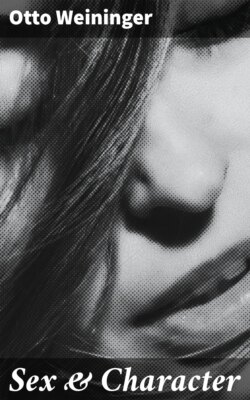Читать книгу Sex & Character - Otto Weininger - Страница 6
На сайте Литреса книга снята с продажи.
ОглавлениеA = {
α Mα´ W
B = {
β Wβ´ M
| A = { | α M | B = { | β B | |
| α´ W | β´ M |
always remembering that each of the factors α, α´, β, β´ must be greater than 0 and less than unity.
Further proofs of the validity of this conception are numerous, and I have already given, in the preface, a few of the most general. We may recall the existence of “men” with female pelves and female breasts, with narrow waists, overgrowth of the hair of the head; or of “women” with small hips and flat breasts, with deep bass voices and beards (the presence of hair on the chin is more common than is supposed, as women naturally are at pains to remove it; I am not speaking of the special growth that often appears on the faces of women who have reached middle age). All such peculiarities, many of them coinciding in the same individuals, are well known to doctors and anatomists, although their general significance has not been understood.
One of the most striking proofs of the view that I have been unfolding is presented by the great range of numerical variation to be found where sexual characters have been measured either by the same or by different anthropological or anatomical workers. The figures obtained by measuring female characters do not begin where those got from males leave off, but the two sets overlap. The more obvious this uncertainty in the theory of sexual intermediate forms may be, the more is it to be deplored in the interests of true science. Anatomists and anthropologists of the ordinary type have by no means striven against the scientific representation of the sexual types, but as for the most part they regarded measurements as the best indications, they were overwhelmed with the number of exceptions, and thus, so far, measurement has brought only vague and indefinite results.
The course of statistical science, which marks off our industrial age from earlier times, although perhaps on account of its distant relation to mathematics it has been regarded as specially scientific, has in reality hindered the progress of knowledge. It has dealt with averages, not with types. It has not been recognised that in pure, as opposed to applied, science it is the type that must be studied. And so those who are concerned with the type must turn their backs on the methods and conclusions of current morphology and physiology. The real measurements and investigations of details have yet to be made. Those that now exist are inapplicable to true science.
Knowledge must be obtained of male and female by means of a right construction of the ideal man and the ideal woman, using the word ideal in the sense of typical, excluding judgment as to value. When these types have been recognised and built up we shall be in a position to consider individual cases, and their analysis as mixtures in different proportions will be neither difficult not fruitless.
I shall now give a summary of the contents of this chapter. Living beings cannot be described bluntly as of one sex or the other. The real world from the point of view of sex may be regarded as swaying between two points, no actual individual being at either point, but somewhere between the two. The task of science is to define the position of any individual between these two points. The absolute conditions at the two extremes are not metaphysical abstractions above or outside the world of experience, but their construction is necessary as a philosophical and practical mode of describing the actual world.
A presentiment of this bisexuality of life (derived from the actual absence of complete sexual differentiation) is very old. Traces of it may be found in Chinese myths, but it became active in Greek thought. We may recall the mythical personification of bisexuality in the Hermaphroditos, the narrative of Aristophanes in the Platonic dialogue, or in later times the suggestion of a Gnostic sect (Theophites) that primitive man was a “man-woman.”
